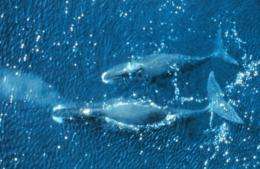September 22, 2011 report
Bowhead whales using the Northwest Passage

(PhysOrg.com) -- According to a new study published in Biology Letters, the climate changes and melting of ice in the Northwest Passage are leading to the mingling of two bowhead whale populations that have been separated by ice for close to 10,000 years.
The researchers, led by Mads Peter Heide-Jorgensen from the Greenland Institute of Natural Resources, have tagged more than 100 bowheads with satellite tracking systems over the last 10 years. Recent travels into the Northwest Passage confirm previous DNA samples that showed that these two different populations have mingled before.
Previously discovered bones found in Nunavut’s High Artic islands show that between 8,500 and 11,000 year ago there was open water in the Passage for the whales to travel between the Atlantic and Pacific, but until recently, this had been restricted by frozen waters.
The first evidence of bowhead whales moving into the Northwest Passage occurred in 2002. A 40 foot male bowhead whale from West Greenland traveled 93 degrees W. in the Northwest Passage in the fall months before turning around and heading to the Hudson Straight.
The fall of 2006 found another male whale from Alaska traveling east to Banks Island. However, both this whale and the whale from 2002 were unable to travel any farther because of dense ice blocking the passage.
In 2010, the passage was nearly ice free by August 10 and the researchers tracked two male whales, one coming from each direction in September. Both of the whales arrived in the Viscount Melville Sound and spent two weeks in the area before crossing paths in the Parry Channel and returning home.
The researchers are unclear as to what attracted the whales to this area as it is not known for producing high feeding opportunities. They do note that all the whales they have tracked into the area are males and may indicate that the males are more exploratory than female whales.
The declining amount of ice in the Northwest Passage may open up areas that the bowhead whales have not inhabited for many years. The presence of bowhead whales are not the only whales that have been seen in the Northwest Passage in recent years. Belugas and narwhals have also been spotted.
More information: The Northwest Passage opens for bowhead whales, Biology Letters, Published online before print September 21, 2011, doi:10.1098/rsbl.2011.0731
Abstract
The loss of Arctic sea ice is predicted to open up the Northwest Passage, shortening shipping routes and facilitating the exchange of marine organisms between the Atlantic and the Pacific oceans. Here, we present the first observations of distribution overlap of bowhead whales (Balaena mysticetus) from the two oceans in the Northwest Passage, demonstrating this route is already connecting whales from two populations that have been assumed to be separated by sea ice. Previous satellite tracking has demonstrated that bowhead whales from West Greenland and Alaska enter the ice-infested channels of the Canadian High Arctic during summer. In August 2010, two bowhead whales from West Greenland and Alaska entered the Northwest Passage from opposite directions and spent approximately 10 days in the same area, documenting overlap between the two populations.
© 2011 PhysOrg.com


















